Interactive Soundscape Mapping for 18th-Century Naples: A Historically Informed Approach
Abstract
1. Introduction
2. Method
3. Interactive Soundscape Mapping
3.1. Historical Soundscape Data Acquisition and Text Analysis
3.2. Sound Source Information and Scenario Development
3.3. Sample Recording
3.4. D Architectural Space Modelling
3.5. Auralization—Spatialization
3.6. Gamification
4. Results and Discussion
5. Conclusions and Future Work
Supplementary Materials
Author Contributions
Funding
Data Availability Statement
Acknowledgments
Conflicts of Interest
Abbreviations
| AAR | Augmented Audio Reality |
| HIP | Historically Informed Performance |
| HIS | Historically Informed Soundscape |
| NLP | Natural Language Processing |
| UE4 | Unreal Engine 4 |
| VAR | Virtual Audio Reality |
| VE | Virtual Environment |
Appendix A
Appendix A.1. Largo Di Palazzo and the Soundscape of 18th-Century Naples
Appendix A.2. Visual Analysis
- -
- Antonio Joli, Largo San Gaetano, 18th century, oil on canvas, Beaulieu, National Motor Museum;
- -
- Antonio Joli, Fiera al Largo di Palazzo, oil on canvas, Beaulieu, National Motor Museum;
- -
- Caspar van Wittel, La veduta di Largo di Palazzo, oil on canvas, Palazzo Zevallos Stigliano (Palazzo Colonna di Stigliano), https://it.m.wikipedia.org/wiki/File:Gaspar_van_wittel,_veduta_di_napoli_con_largo_di_palazzo,_1700-25_ca.JPG (accessed on 11 May 2025);
- -
- Pietro Fabris, Cavalcata Turca, ca. 1778, oil on canvas, 52.1 × 78.7 cm, private collection;
- -
- Caspar van Wittel, Naples: View of the Darsena delle Galere, 1703, oil on canvas, National Maritime Museum, Greenwich, London, Caird Collection, https://www.rmg.co.uk/collections/objects/rmgc-object-13378 (accessed on 11 May 2025);
- -
- Antonio Joli, La Porta dello Santo Spirito, 18th century, oil on canvas, Beaulieu, National Motor Museum;
- -
- Antonio Joli, Strada di Santa Maria di Constantinopoli, ca. 1759, oil on canvas, 50 × 78 cm, current location unknown; Antonio Joli, Palazzo Reale e Castelnuovo, oil on canvas, National Motor Museum, Beaulieu, UK;
- -
- Caspar van Wittel, Crypta Neapolitana, oil on canvas, current location unknown, https://nl.m.wikipedia.org/wiki/Bestand:Caspar_van_Wittel_-_Crypta_Neapolitana.jpg (accessed on 11 May 2025);
- -
- Antonio Joli, Strada del Real Teatro di San Carlo, 18th century, oil on canvas, National Motor Museum, Beaulieu, UK;
- -
- Antonio Joli, Largo del Mercato, 18th century, oil on canvas, National Motor Museum, Beaulieu, UK;
- -
- Antonio Joli, Napoli dal porto, 18th century, oil on canvas, National Motor Museum, Beaulieu, UK;
- -
- Caspar van Wittel, Naples: A View of the Riviera, early 18th century, oil on canvas, current location unknown, https://commons.wikimedia.org/wiki/File:Gaspar_van_wittel_called_vanvitelli_view_of_the_riviera_di_chiaia_nap.jpg (accessed on 11 May 2025);
- -
- Pietro Antoniani, Landscape of Naples from Mergellina, late 18th century, oil on canvas, Casa Lempronti Collection;
- -
- Sclopis Ignazio Lorenzo Ludovico, Veduta di Napoli dalla parte di Chiaia Georgiana Spencer 1764 Seduta di Napoli da Chiaia 1764, etching on paper, 52.5 × 75 cm, Royal Museums-Sabauda Gallery;
- -
- Pietro Fabris, The Bay of Naples from Posillipo, late 18th century, oil on canvas, Compton Verney, UK, https://commons.wikimedia.org/wiki/File:Pietro_Fabris_The_Bay_of_Naples_from_Posillipo.jpg (accessed on 11 May 2025);
- -
- Antonio Joli, Largo di Castello in Neapel, 18th century, oil on canvas, Kunsthistorisches Museum, Vienna).
References
- Zannoni, G.A.R. Pianta Della Citta Di Napoli Come Esiste Nel Presenta Anno 1790. Available online: https://gallica.bnf.fr/ark:/12148/btv1b530300451 (accessed on 8 November 2020).
- Firat, H.B.; Masullo, M.; Maffei, L. Digital Humanities in the Historical Soundscape Research: Sound of 18th Century Naples. In Proceedings of the 2nd Symposium: The Acoustics of Ancient Theatres, Verona, Italy, 6–8 July 2022. [Google Scholar]
- Planells, A.; Segura, J.; Barba, A.; Cerdá, S.; Giménez, A.; Cibrián, R.M. Virtual Acoustic Reconstruction of the Church at the Lost Monastery of Santa Maria de La Murta. In Augmented and Virtual Reality; De Paolis, L., Mongelli, A., Eds.; Springer International Publishing: Cham, Switzerland, 2014; pp. 457–464. [Google Scholar]
- Autio, H.; Barbagallo, M.; Ask, C.; Bard Hagberg, D.; Lindqvist Sandgren, E.; Strinnholm Lagergren, K. Historically Based Room Acoustic Analysis and Auralization of a Church in the 1470s. Appl. Sci. 2021, 11, 1586. [Google Scholar] [CrossRef]
- Boren, B.B.; Longair, M.S. Acoustic Simulation of Renaissance Venetian Churches. Acoust. Pract. 2013, 1, 17–28. [Google Scholar] [CrossRef]
- Boren, B.B. Acoustic Simulation of J.S. Bach’s Thomaskirche in 1723 and 1539. Acta Acust. 2021, 5, 14. [Google Scholar] [CrossRef]
- Canfield-Dafilou, E.K.; Katz, B.F.G.; Caseau Chevallier, B. History and Acoustics of Preaching in Notre-Dame de Paris. Heritage 2024, 7, 6614–6628. [Google Scholar] [CrossRef]
- Alonso, A.; Suárez, R.; Sendra, J.J. The Acoustics of the Choir in Spanish Cathedrals. Acoustics 2018, 1, 35–46. [Google Scholar] [CrossRef]
- Martellotta, F. Subjective Study of Preferred Listening Conditions in Italian Catholic Churches. J. Sound Vib. 2008, 317, 378–399. [Google Scholar] [CrossRef]
- Martellotta, F.; Cirillo, E.; Della Crociata, S.; Gasparini, E.; Preziuso, D. Acoustical Reconstruction of San Petronio Basilica in Bologna during the Baroque Period: The Effect of Festive Decorations. J. Acoust. Soc. Am. 2008, 123, 3607. [Google Scholar] [CrossRef]
- Elicio, L.; Martellotta, F. Acoustics as a Cultural Heritage: The Case of Orthodox Churches and of the “Russian Church” in Bari. J. Cult. Herit. 2015, 16, 912–917. [Google Scholar] [CrossRef]
- Iannace, G.; Trematerra, A.; Masullo, M. The Large Theatre of Pompeii: Acoustic Evolution. Build. Acoust. 2013, 20, 215–227. [Google Scholar] [CrossRef]
- Lokki, T.; Southern, A.; Siltanen, S.; Savioja, L. Acoustics of Epidaurus—Studies with Room Acoustics Modelling Methods. Acta Acust. United Acust. 2013, 99, 40–47. [Google Scholar] [CrossRef]
- Farnetani, A.; Prodi, N.; Pompoli, R. On the Acoustics of Ancient Greek and Roman Theatres. J. Acoust. Soc. Am. 2008, 124, 1557–1567. [Google Scholar] [CrossRef] [PubMed]
- Tronchin, L.; Merli, F.; Dolci, M. Virtual Acoustic Reconstruction of the Miners’ Theatre in Idrija (Slovenia). Appl. Acoust. 2021, 172, 107595. [Google Scholar] [CrossRef]
- Iannace, G.; Ianniello, C.; Maffei, L.; Romano, R. Objective Measurement of the Listening Condition in the Old Italian Opera House “Teatro Di San Carlo”. J. Sound Vib. 2000, 232, 239–249. [Google Scholar] [CrossRef]
- Prodi, N.; Pompoli, R.; Martellotta, F.; Sato, S. Acoustics of Italian Historical Opera Houses. J. Acoust. Soc. Am. 2015, 138, 769–781. [Google Scholar] [CrossRef] [PubMed]
- Gül, Z.S. Review on Acoustics Timeline of Hagia Sophia and Süleymaniye Mosque in Istanbul. In Proceedings of the International Congress on Acoustics, Achen, Germany, 9–13 September 2019; pp. 2351–2358. [Google Scholar] [CrossRef]
- Gül, Z.S.; Çalışkan, M.; Tavukçuoğlu, A. On The Acoustics of Süleymaniye Mosque: From Past to Present. MEGARON/Yıldız Tech. Univ. Fac. Archit. E-J. 2014, 9, 201–216. [Google Scholar] [CrossRef]
- Alves, S.; Gabriele, M.D.; Masullo, M.; Maffei, L. Exploring the Soundscape and the Atmosphere of the Gigli Di Nola Cultural Festival in Italy. Emot. Space Soc. 2021, 41, 100848. [Google Scholar] [CrossRef]
- Maffei, L.; Brambilla, G.; Di Gabriele, M. Soundscape as Part of the Cultural Heritage. In Soundscape and the Built Environment; CRC Press: Boca Raton, FL, USA, 2015; pp. 215–242. ISBN 978-1-4822-2631-7. [Google Scholar]
- Fırat, H.B. Acoustics as Tangible Heritage: Re-Embodying the Sensory/Acoustic Heritage in the Boundless Reign of the Sight. Preserv. Digit. Technol. Cult. 2020, 50, 3–14. [Google Scholar] [CrossRef]
- Can, F.Z.Y. Virtual Conservation of Acoustical Heritage: Cahrisma and Erato Projects. In Proceedings of the Forum Acusticum, Budapest, Hungary, 29 August–2 September 2005. [Google Scholar]
- Rindel, J.H. Roman Theatres and Revival of Their Acoustics in the ERATO Project. Acta Acust. United Acust. 2013, 99, 21–29. [Google Scholar] [CrossRef]
- Yüksel, Z.; Erdoğan, S.; Ayangil, R.; Ünver, R.; Binan, C.; Can, C. Audio-Visual Conservation and Restitution of the Ancient Theatres and Odea in Virtual Environment: ERATO Research Project. Megaron YTU Arch. Fac. E-J. 2005, 1, 1–8. [Google Scholar]
- Yüksel Can, F.Z. A Research on Sinans Mosques within the 5th Framework Program of the European Environmental Commission the CAHRISMA Project. Tasarım 2000, 102, 79–83. Available online: https://avesis.yildiz.edu.tr/yayin/830d7b22-2655-4800-b313-a661581ce4de/a-research-on-sinans-mosques-within-the-5th-framework-program-of-the-european-environmental-commission-the-cahrisma-project (accessed on 11 May 2025).
- Yüksel, Z.; Erdoğan, S. Virtual Conservation of Acoustical Heritage: CAHRISMA and ERATO Projects Introduction and ERATO Projects CAHRISMA Virtual Conservation and Restitution of the Acoustical Heritage. In Proceedings of the Forum American Bar Association; EAA: Budapest, Hungary, 2006; pp. 2167–2172. [Google Scholar]
- Postma, B.N.J.; Katz, B.F.G. An Archaeoacoustic Study on Shape: The Case Study of the Iffland Theatre’s History (1802–1817). Acta Acust. 2023, 7, 54. [Google Scholar] [CrossRef]
- Postma, B.N.J.; Dubouilh, S.; Katz, B.F.G. An Archeoacoustic Study of the History of the Palais Du Trocadero (1878–1937). J. Acoust. Soc. Am. 2019, 145, 2810–2821. [Google Scholar] [CrossRef] [PubMed]
- Katz, B.F.G.; Cros, C.; Peichert, S.; De Muynke, J. The Past Has Ears at Notre-Dame: Acoustic Digital Twins for Research and Narration. Digit. Appl. Archaeol. Cult. Herit. 2024, 34, e00369. [Google Scholar] [CrossRef]
- Katz, B.; Weber, A. An Acoustic Survey of the Cathédrale Notre-Dame de Paris before and after the Fire of 2019. Acoustics 2020, 2, 791–802. [Google Scholar] [CrossRef]
- Howard, D.; Moretti, L. Sound and Space in Renaissance Venice Architecture, Music, Acoustics; Yale University Press: New Haven, CT, USA, 2010. [Google Scholar]
- Pentcheva, B.V. The Sensual Icon, Space, Ritual, and the Senses in Byzantium; Penn State University: University Park, PA, USA, 2010. [Google Scholar]
- Briatore, S. Immaginare i Suoni. Ricostruzione Del Paesaggio Sonoro Della Festa Barocca. Arti Dello Spett./Perform. Arts 2017, 3, 91–100. [Google Scholar]
- Pardoen, M. Projet Bretez: Une Pincée de Son Dans l’Histoire. Digit. Stud./Le Champ Numérique 2019, 9, 1–17. [Google Scholar] [CrossRef]
- Pardoen, M. Les Oreilles à l’affût—Restitution d’un Paysage Sonore: Œuvre de l’imaginaire Ou Recherche d’authenticité ?, Silences et Bruits Du Moyen-Âge à Nos Jours. In Perception Identités Sonores et Patrimonialisation; Aubrun, J., Ed.; L’Harmattan: Paris, France, 2015; pp. 145–161. [Google Scholar]
- Lopez, M. An Acoustical Approach to the Study of the Wagons of the York Mystery Plays: Structure and Orientation. Early Theatre 2015, 18, 11–36. [Google Scholar] [CrossRef]
- Bijsterveld, K. Ears-on Exhibitions: Sound in the History Museum. Public Hist. 2015, 37, 73–90. [Google Scholar] [CrossRef]
- Griffin, A. Virtual Reality and Social Media Elections: Looking Back at 2016 Tech News and Predictions for 2017. The Independent. Available online: https://www.independent.co.uk/life-style/gadgets-and-tech/features/tech-news-2016-round-up-2017-predictions-vr-virtual-reality-social-media-apple-a7472926.html (accessed on 15 November 2018).
- DECIMA. We Put Florentine History on the Map. Available online: https://decima-map.net/ (accessed on 8 November 2020).
- Naples Digital Archive. Bibliotheca Hertziana—Max Planck Institut for Art History. Available online: https://www.biblhertz.it/de/dept-michalsky/editing-naples/naples-digital-archive (accessed on 8 November 2020).
- Jimenez, J.R.; Rus, I.J.L. Historical Soundscapes (c.1200–c.1800): An On-Line Digital Platform. In Hearing the City in Early Modern Europe; Knighton, T., Mazuela-Anguita, A., Eds.; Brepols Publishers: Turnhout, Belgium, 2018; p. 428. ISBN 978-2-503-57959-7. [Google Scholar]
- Belotti, S.; Fiore, A. Mapping the Historical Soundscape. A Digital Project to Enhance the Cultural Identity of Modena (Italy). Abstr. ICA 2022, 5, 95. [Google Scholar] [CrossRef]
- Belotti, S.; Fiore, A. Alla Corte Degli Este, Tra Musica e Cartografia: Spunti per La Ricostruzione Del Paesaggio Sonoro Di Una Città Ducale (Sec. XVII). In Proceedings of the Convegno Internazionale Rethinking the Soundscape: Musical Events and the Soundscape of Italian Cities, XVI–XIX Century, Rome, Italy, 6–8 June 2019. [Google Scholar]
- Fırat, H.B.; Maffei, L.; Masullo, M. 3D Sound Spatialization with Game Engines: The Virtual Acoustics Performance of a Game Engine and a Middleware for Interactive Audio Design. Virtual Real. 2022, 26, 539–558. [Google Scholar] [CrossRef]
- Poirier-Quinot, D.; Katz, B.F.G.; Noisternig, M. Evertims: Open Source Framework for Real-Time Auralization in Architectural Acoustics and Virtual Reality. In Proceedings of the DAFx 2017, Edinburgh, Scotland, 5–9 September 2017; pp. 323–328. [Google Scholar]
- Institute of Technical Acoustics RWTH Aachen University Virtual Acoustics—A Real-Time Auralization Framework for Scientific Research. Available online: https://www.virtualacoustics.org/VA/ (accessed on 16 March 2018).
- Fırat, H.B.; Masullo, M.; Maffei, L. A Methodology for the Historically Informed Soundscape. In Proceedings of the 2020 International Congress on Noise Control Engineering, Seoul, Republic of Korea, 23–26 August 2020; Jeon, J.Y., Ed.; Institute of Noise Control Engineering: Wakefield, MA, USA, 2020. [Google Scholar]
- Pearse, D.L.; Waltner, A.; Godsoe, C.N. Historically Informed Soundscape: Mediating Past and Present. J. Sonic Stud. 2017, 15. [Google Scholar]
- Carter, T. Some Thoughts on (Early Modern) Sound, Space, and Time. In Music, Place, and Identity in Italian Urban Soundscapes Circa 1550–1860; Caputo, S., Piperno, F., Senici, E., Eds.; Routledge: New York, NY, USA, 2023. [Google Scholar]
- Rostagno, A. Historical Urban Phonosphere. In Music, Place, and Identity in Italian Urban Soundscapes Circa 1550–1860; Caputo, S., Piperno, F., Senici, E., Eds.; Routledge: New York, NY, USA, 2023. [Google Scholar]
- Rath, R.C. Hearing American History. J. Am. Hist. 2008, 95, 417–431. [Google Scholar] [CrossRef]
- Antonelli, A. (Ed.) Cerimoniale Del Viceregno Austriaco Di Napoli 1707–1734; Arte’m: Naples, Italy, 2014. [Google Scholar]
- Antonelli, A. (Ed.) Cerimoniale Dei Borbone Di Napoli 1734–1801; Arte’m: Naples, Italy, 2017. [Google Scholar]
- Sigismondo, G. Descrizione Della Città Di Napoli e Suoi Borghi Del Dottor Giuseppe Sigismondo Napoletano; Fratelli Terres: Naples, Italy, 1778. [Google Scholar]
- duca di Noja Carafa, G. Lettera Ad Un Amico Contenente Alcune Considerazioni Sull’utilità e Gloria Che Si Trarrebbe Da Una Esatta Carta Topografica Della Città Di Napoli e Del Suo Contado. Naples, Italy, 1775. Available online: https://archive.org/details/bub_gb_27zMQhVm-GwC/page/n7/mode/2up (accessed on 25 July 2020).
- Galanti, G.M. Breve Descrizione Della Città Di Napoli e Del Suo Contorno; Presso li Soci del Gabinetto Letterario: Florence, Italy, 1792. [Google Scholar]
- Seta, C.D. Napoli Dalle Origini All’Ottocento; Arte’m: Naples, Italy, 1981. [Google Scholar]
- Bruno, G. Case e Botteghe: Cultura Materiale e Vita Quotidiana a Napoli Nel Settecento; Universita degli Studi di Napoli Federico II: Naples, Italy, 2016. [Google Scholar]
- Caravaglios, C. Voci e Gridi Di Venditori in Napoli; Instituto Grafico Editoriale Italiano: Naples, Italy, 2004. [Google Scholar]
- Squillace, G. A Fronna ’e Limone e Gli Altri Canti Del Popolo Napoletano. Available online: https://www.vesuviolive.it/cultura-napoletana/133702-fronna-limone-gli-altri-canti-del-popolo-napoletano/ (accessed on 28 September 2020).
- Di Mauro, R. Improvvisazione Popolare e Urbana a Napoli Nel Primo Ottocento: Dai Canti Del Molo A “Io Te Voglio Bene Assaje”. In Beyond Notes. Improvisation in Western Music of the Eighteenth and Nineteenth Century; Rasch, R., Ed.; Brepols Publishers: Turnhout, Belgium, 2011; pp. 317–334. [Google Scholar]
- Fırat, H.B.; Masullo, M.; Maffei, L. Room Impulse Response in Game Engines. In Proceedings of the Beyond All Limits 2018: International Congress on Sustainability in Architecture, Planning, and Design, Ankara, Turkey, 17–19 October 2018; Çankaya University Press: Ankara, Turkey, 2018; pp. 344–348. [Google Scholar]
- Fırat, H.B. 18th-Century Naples Interactive Soundscape Map. YouTube. Available online: https://www.youtube.com/watch?v=hPycON7tPJA (accessed on 14 December 2021).
- Atkinson, N. Getting Lost in the Italian Renaissance. I Tatti Stud. Ital. Renaiss. 2016, 19, 177–207. [Google Scholar] [CrossRef]
- Smith, B.R. How Sound Is Sound History? A Response to Mark Smith. J. Hist. Soc. 2002, 3–4, 307–315. [Google Scholar] [CrossRef]
- Smith, M.M. A Sensory History Manifesto; The Pennsylvania State University Press: University Park, PA, USA, 2021. [Google Scholar]
- Colletta, T. Piazza Plebiscito a Napoli. In Le Piazze Italiane dal Medioevo all’Ottocento; Kappa Edizioni: Rome, Italy, 2006. [Google Scholar]
- Deldonna, A.R. Opera, Theatrical Culture and Society in Late Eighteenth-Century Naples; Routledge: New York, NY, USA, 2016. [Google Scholar]
- Astarita, T. Introduction: “Naples Is the Whole World”. In A Companion to Early Modern Naples; Astarita, T., Ed.; Brill: Leiden, The Netherlands, 2013. [Google Scholar]
- Magaudda, A.; Costantini, D. The Musical and Theatrical Activities of the Jesuits in the Kingdom of Naples: Accounts from the Gazzetta Di Napoli (1675–1768). In Music as Cultural Mission: Explorations of Jesuit Practices in Italy and North America; Celenza, A.H., DelDonna, A.R., Eds.; Saint Joseph’s University Press: Philedelphia, PA, USA, 2014. [Google Scholar]
- Calaresu, M. From the Street to Stereotype: Urban Space, Travel and the Picturesque in Late Eighteenth-Century Naples. Ital. Stud. 2007, 62, 189–201. [Google Scholar] [CrossRef]
- Marino, J.A. Becoming Neapolitan: Citizen Culture in Baroque Naples; The Johns Hopkins University Press: Baltimore, MA, USA, 2010. [Google Scholar]
- Guarino, G. Public Rituals and Festivals in Naples, 1503–1799. In A Companion to Early Modern Naples; Astarita, T., Ed.; Brill: Leiden, The Netherlans, 2013; pp. 257–279. [Google Scholar]
- Traversier, M. Music as Dangerous Urban Leisure: Safety in and around Public Theatres in Enlightenment Naples. In Hearing the City in Early Modern Europe; Knighton, T., Mazuela-Anguita, A., Eds.; Brepols Publishers: Turnhout, Belgium, 2018. [Google Scholar]
- Calaresu, M. The Patriots and the People in Late Eighteenth-Century Naples. Hist. Eur. Ideas 1995, 20, 203–209. [Google Scholar] [CrossRef]

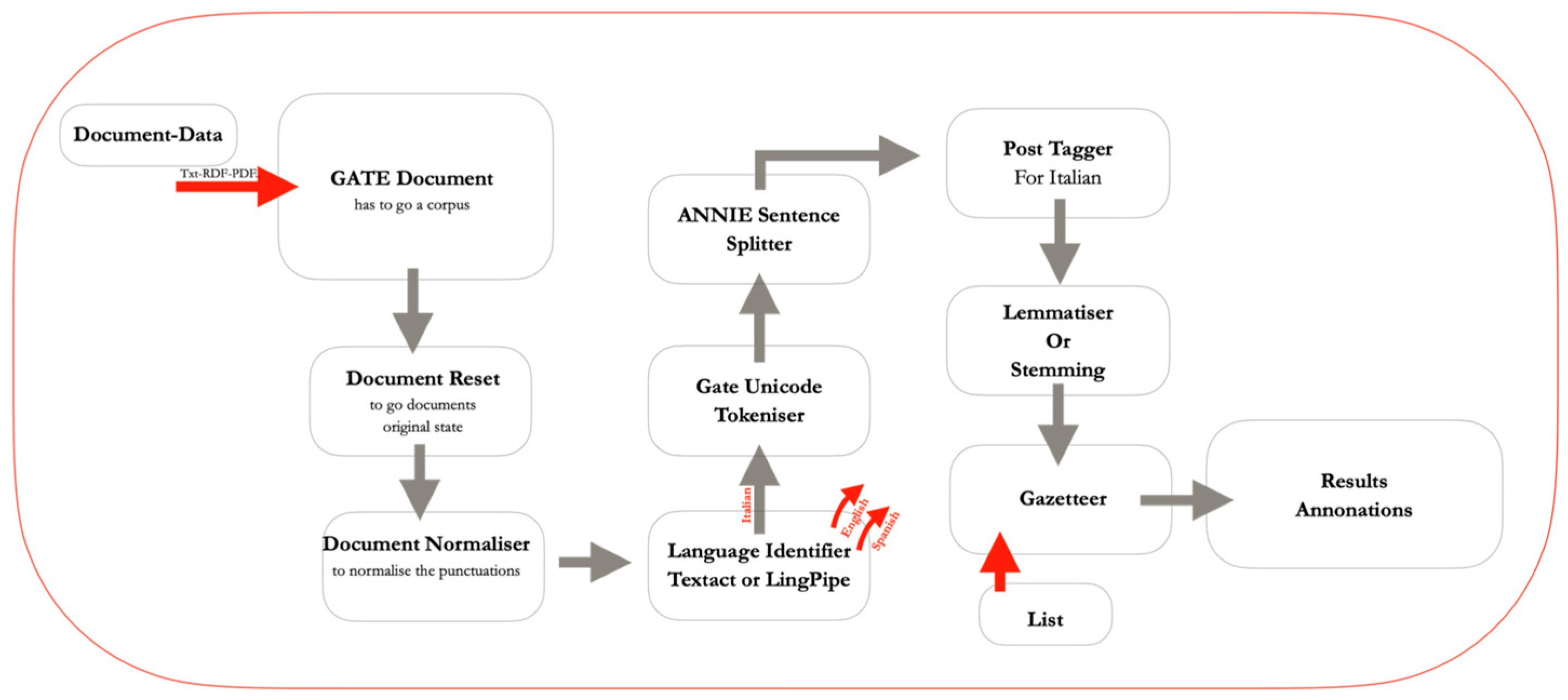
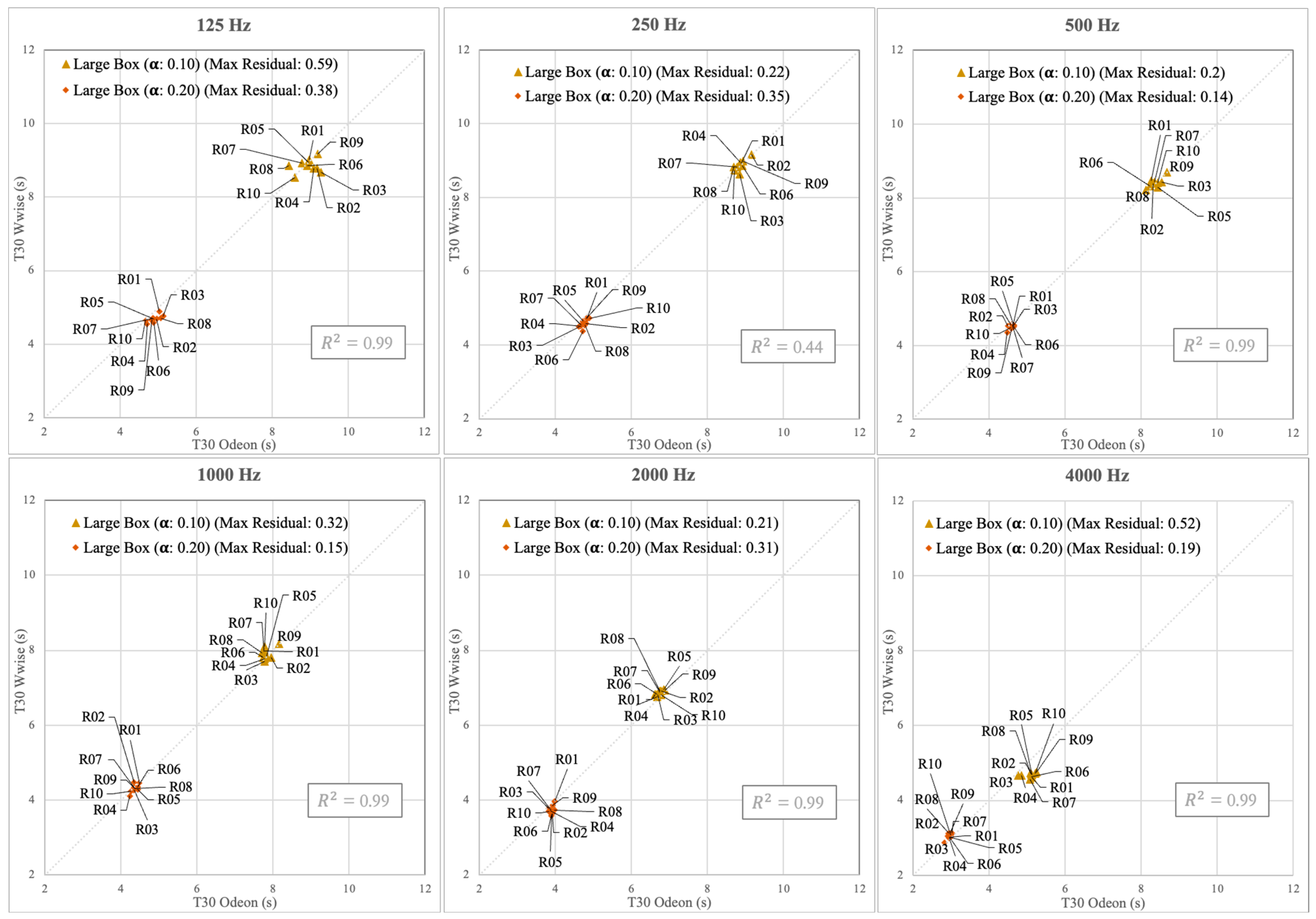
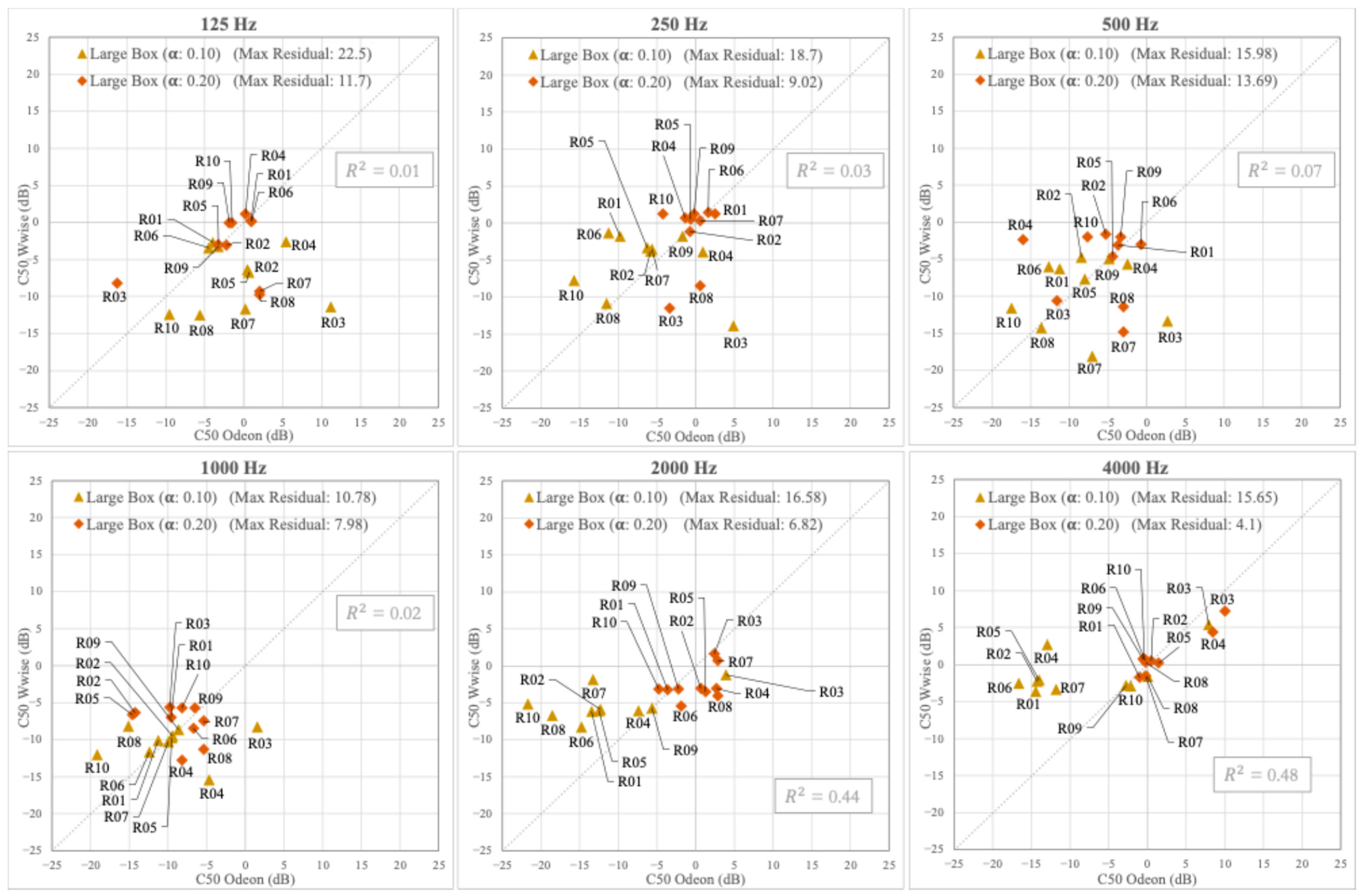
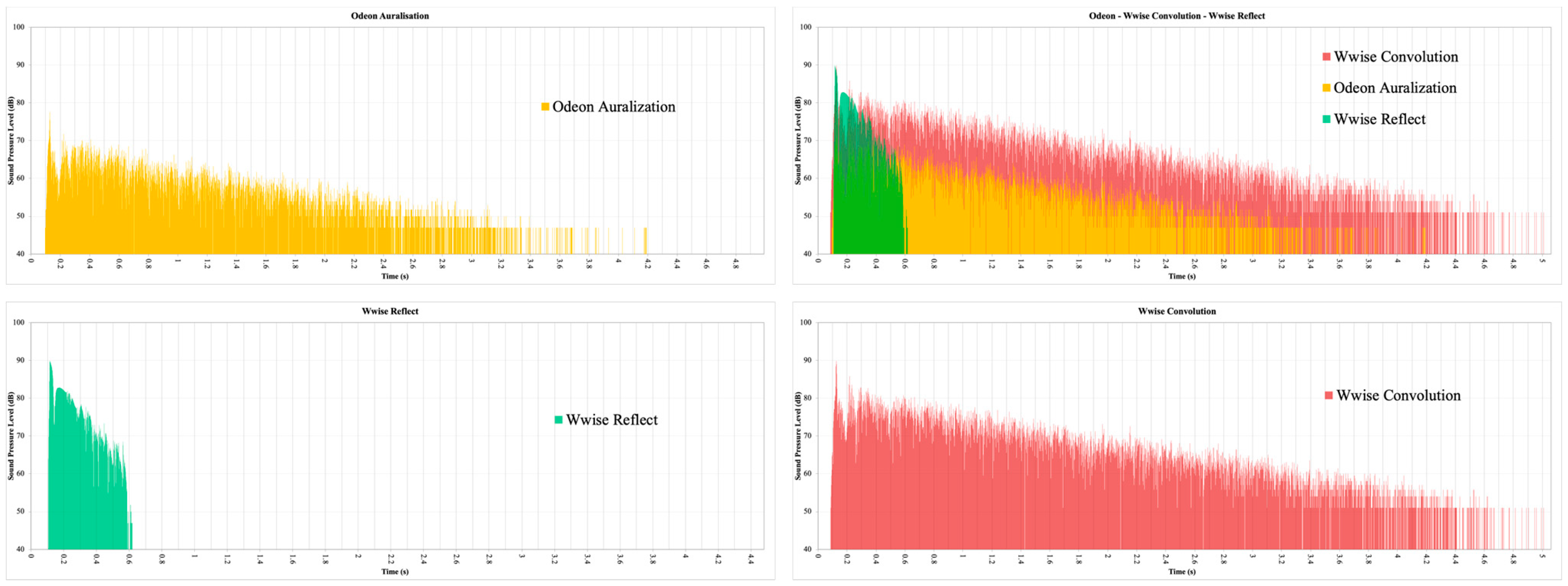

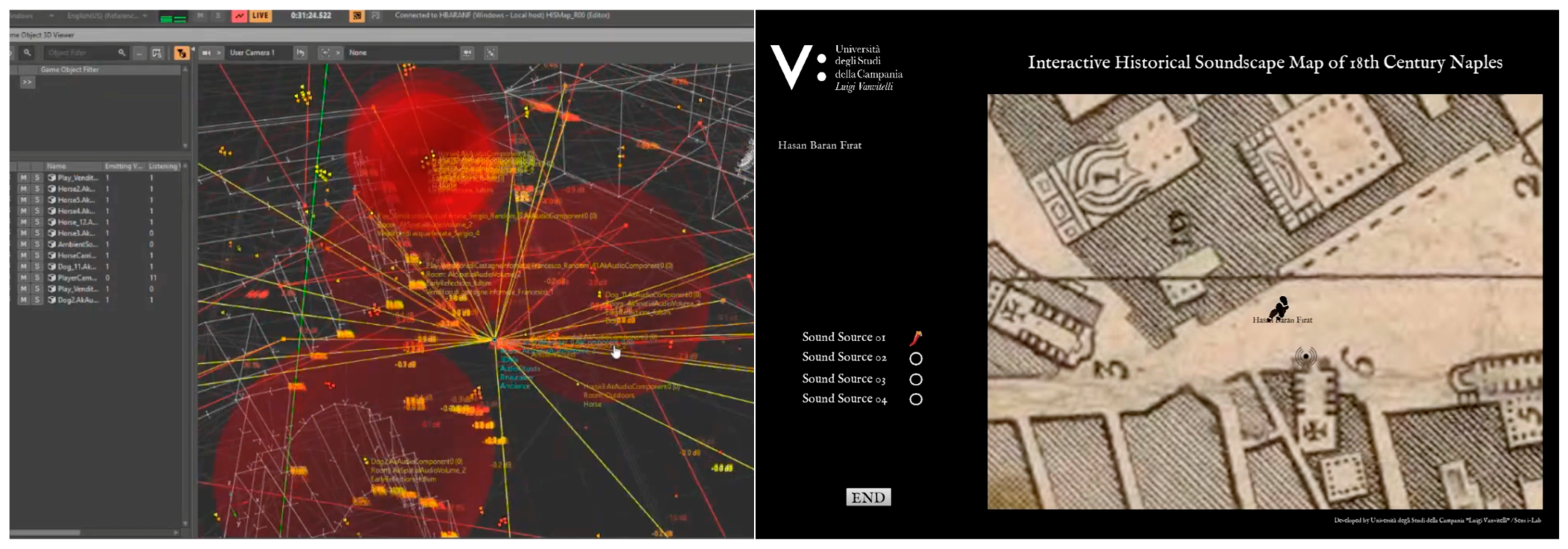
Disclaimer/Publisher’s Note: The statements, opinions and data contained in all publications are solely those of the individual author(s) and contributor(s) and not of MDPI and/or the editor(s). MDPI and/or the editor(s) disclaim responsibility for any injury to people or property resulting from any ideas, methods, instructions or products referred to in the content. |
© 2025 by the authors. Licensee MDPI, Basel, Switzerland. This article is an open access article distributed under the terms and conditions of the Creative Commons Attribution (CC BY) license (https://creativecommons.org/licenses/by/4.0/).
Share and Cite
Firat, H.B.; Masullo, M.; Maffei, L. Interactive Soundscape Mapping for 18th-Century Naples: A Historically Informed Approach. Acoustics 2025, 7, 28. https://doi.org/10.3390/acoustics7020028
Firat HB, Masullo M, Maffei L. Interactive Soundscape Mapping for 18th-Century Naples: A Historically Informed Approach. Acoustics. 2025; 7(2):28. https://doi.org/10.3390/acoustics7020028
Chicago/Turabian StyleFirat, Hasan Baran, Massimiliano Masullo, and Luigi Maffei. 2025. "Interactive Soundscape Mapping for 18th-Century Naples: A Historically Informed Approach" Acoustics 7, no. 2: 28. https://doi.org/10.3390/acoustics7020028
APA StyleFirat, H. B., Masullo, M., & Maffei, L. (2025). Interactive Soundscape Mapping for 18th-Century Naples: A Historically Informed Approach. Acoustics, 7(2), 28. https://doi.org/10.3390/acoustics7020028







